Accounting for a Diverse Forest Ownership Structure in Projections of Forest Sustainability Indicators
Abstract
:1. Introduction
2. Material and Methods
2.1. Input Data
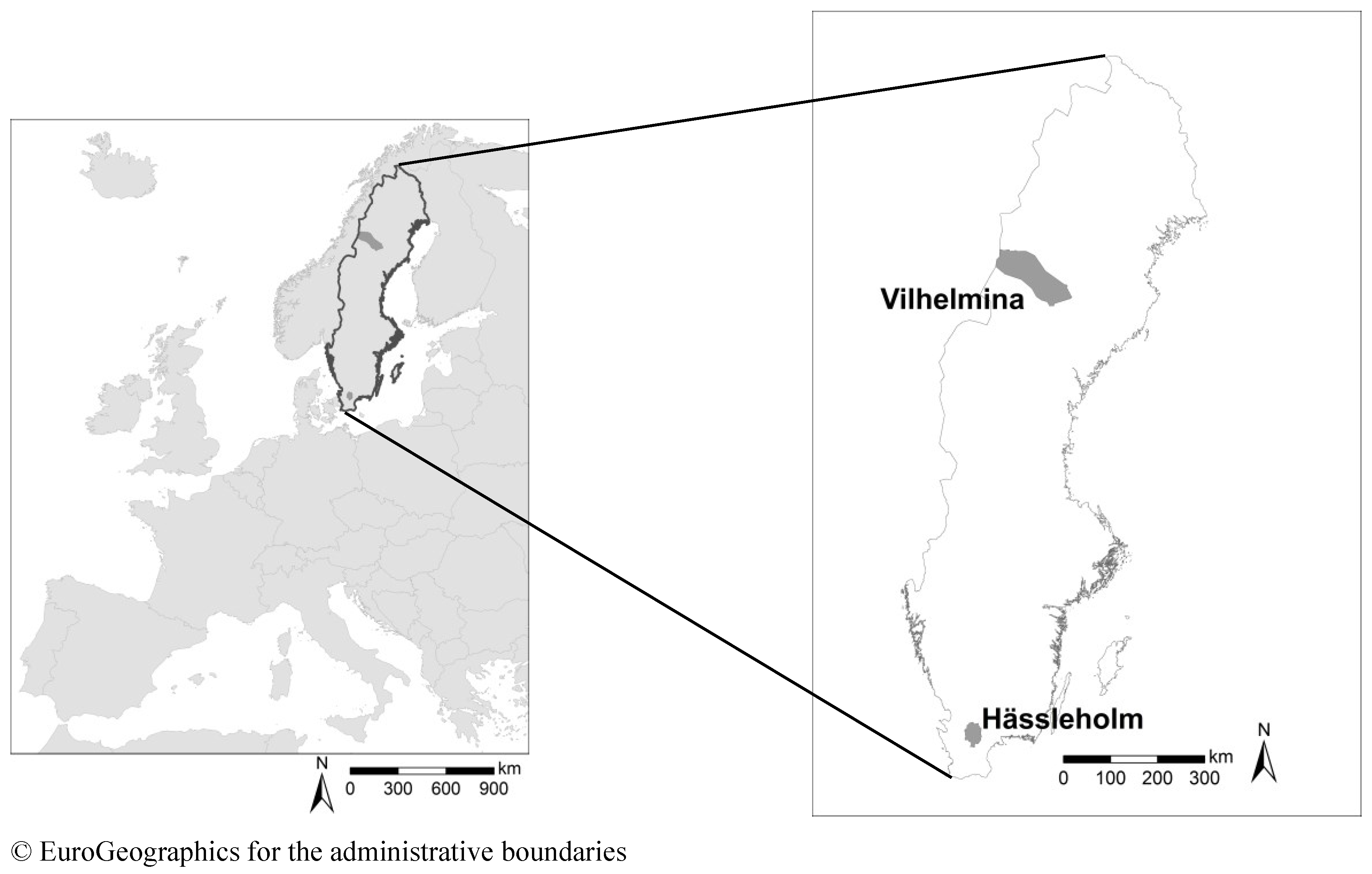
| Hässleholm | Vilhelmina | Source | |
|---|---|---|---|
| Size (km2) | 1306 | 8741 | SCB [27] |
| Inhabitants (2014) | 50,565 | 6848 | SCB [28] |
| Biogeographical region | Continental | Boreal/Alpine | EEA [29] |
| Average length of vegetation period (days with average temperature > 5 °C) | 200 | 120 | SMHI [30] |
| Owner | Hässleholm | Vilhelmina | ||
|---|---|---|---|---|
| Productive Forest Area (ha) | Share (%) | Productive Forest Area (ha) | Share (%) | |
| NIPF owners | 62,721 | 86 | 121,534 | 39 |
| Municipality 1 | 2,937 | 4 | 5,969 | 2 |
| Church | 2,636 | 4 | 1,694 | 1 |
| Forest enterprise | 2,270 | 3 | 70,705 | 22 |
| Foundations | 2,006 | 3 | 0 | 0 |
| National Property Board | 0 | 0 | 80,450 | 26 |
| Forest commons | 0 | 0 | 34,487 | 11 |
| Total | 72,570 | 100 | 314,839 | 100 |
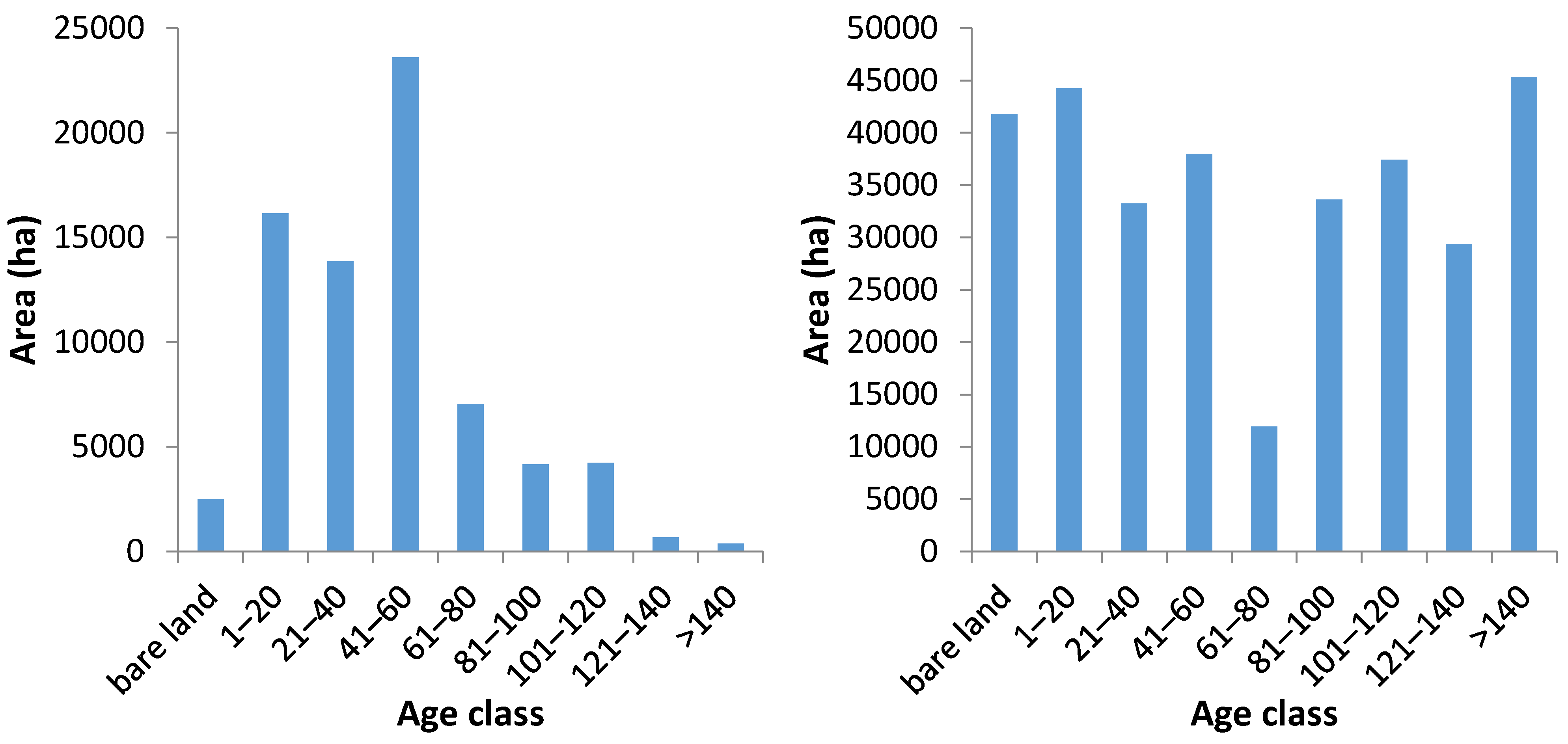
| Tree species | Volume (1000 m3) | Share (%) | ||
|---|---|---|---|---|
| Hässleholm | Vilhelmina | Hässleholm | Vilhelmina | |
| Scots pine (Pinus sylvestris) | 1,035 | 7,548 | 9 | 27 |
| Norway spruce (Picea abies) | 5,528 | 15,793 | 50 | 57 |
| Birch (Betula pubescens and B. pendula) | 1,187 | 3,713 | 11 | 13 |
| Aspen (Populus tremula) | 100 | 236 | 1 | 1 |
| Oak (Quercus robur) | 806 | 0 | 7 | 0 |
| European beech (Fagus sylvatica) | 1,571 | 0 | 14 | 0 |
| Other valuable broadleaves | 249 | 0 | 2 | 0 |
| Lodgepole pine (Pinus contorta) | 0 | 127 | 0 | 0 |
| Other broadleaves | 587 | 215 | 5 | 1 |
| Total | 11,063 | 27,633 | 100 | 100 |
2.2. The Heureka Forest Model
2.3. Model Set-Up
- •
- Passive (“I thin and clear-cut only on a small scale. I let the forest grow old, but I do not expect the harvest to increase in the future.”),
- •
- Conservation (“I harvest only on a small scale, so that the amount of old forest remains constant or increases. My management practices are oriented towards nature protection, for example to increase the proportion of broadleaved forest.”),
- •
- Intensive (“I harvest a lot of wood by thinning, and I clear-cut as soon as the forest age permits.”),
- •
- Productivity (“I manage the forest for increased productivity and future harvest opportunities. Examples of my management practices are planting with soil scarification, pre-commercial thinning, ditching and fertilization.”), and
- •
- Save (“I harvest carefully and my management practices aim to increase harvest opportunities in the medium term.”).
| Owner | Forest Type/Size Class | Management Strategy | ||||||
|---|---|---|---|---|---|---|---|---|
| No mgmt. | Passive | Conservation | Intensive | Productivity | Save | Shelterwood | ||
| All | Protected | 100% | - | - | - | - | - | - |
| Bog forests | - | - | 100% | - | - | - | - | |
| NIPF | 0–20 ha | - | 37% | 16% | 4% | 7% | 36% | - |
| 21–50 ha | - | 18% | 10% | 16% | 25% | 31% | - | |
| >50 ha | - | 5% | 4% | 18% | 49% | 24% | - | |
| Other | Forest enterprise | - | - | - | - | 100% | - | - |
| Municipality | - | - | 50% | - | - | - | 50% | |
| Foundations | - | - | 50% | - | - | - | 50% | |
| Owner | Forest Type/Size Class | Management strategy | |||||||
|---|---|---|---|---|---|---|---|---|---|
| No Mgmt. | Passive | Conservation | Intensive | Productivity | Save | Shelterwood | CCF | ||
| All | Protected | 100% | - | - | - | - | - | - | - |
| Above final felling threshold | 25% | - | - | - | - | - | - | 75% | |
| NIPF | 0–20 ha | - | 34% | 10% | 4% | 12% | 40% | - | - |
| 21–50 ha | - | 33% | 4% | 10% | 26% | 27% | - | - | |
| >50 ha | - | 15% | 8% | 7% | 43% | 27% | - | - | |
| Other | Forest enterprise | - | - | - | - | 100% | - | - | - |
| Municipality 1 | - | - | - | - | 85% | - | 7% | 8% | |
| Forest commons 2 | - | 100% | - | - | - | - | - | - | |
| National Property Board 3 | - | - | 12% | - | 74% | - | - | 14% | |
| Management Strategy | Description |
|---|---|
| No management | The forest is left unmanaged for natural development. |
| Passive | The rotation period is extended by 20%, and only 30% of the net annual increment is harvested. No pre-commercial thinnings are implemented, and commercial thinnings are less common, with a maximum of only 10% of the total harvested volume coming from thinnings. Forest dominated by selected valuable broadleaved species was left unmanaged. |
| Conservation | The rotation period is extended by 50%, and at least 20% of the area is left for natural development (set-aside). During pre-commercial and commercial thinnings, a 30% minimum share of broadleaves is maintained. |
| Intensive | For this management strategy, the only change to the default configuration was that the minimum final felling age was set according to legislation, i.e., there was no rotation period extension. |
| Productivity | The forest is mostly regenerated through plantation with trees from breeding programs, largely spruce. Scots pine was used only on the driest sites. In Vilhelmina, fertilizer is applied and Lodgepole pine is planted to some extent where allowed. |
| Save | The rotation period is extended by 50%. Thinnings are allowed up to a maximum tree height of 30 m (instead of 25 m) and even in older forests (up to a relative age of 1.5). |
| Shelterwood | The forest is regenerated with shelterwood to a great extent, and the rotation period is extended by 50%. |
| CCF | Continuous cover forestry: No final fellings take place; instead the forest is managed through a continually repeated series of selective harvests. |
| Simple—NIPF | Parameters for the regeneration method, species and soil scarification method, tree breeding and set-aside for nature conservation were taken from the reference scenario of the latest available national forest impact analysis [2]. Minimum final felling age was set according to legislation, i.e., there was no rotation period extension. In addition to protected unmanaged forest (key biotopes, nature reserves and Natura 2000), 8.1% of the productive forest area was set-aside for nature conservation in Hässleholm, and 4.2% in Vilhelmina. |
| Simple—Other | Parameters for the regeneration method, species and soil scarification method, tree breeding and set-aside for nature conservation were taken from the reference scenario of the latest available national forest impact analysis [2]. In addition to protected unmanaged forest (key biotopes, nature reserves and Natura 2000), 18.1% of the productive forest area was set-aside for nature conservation in Hässleholm, and 3.7% in Vilhelmina. |
2.4. Sensitivity Analysis
| Diverse | Diverse_m | Diverse_l | |
|---|---|---|---|
| Passive | |||
| Harvest level | 30% | 50% | 10% |
| Rotation extension | 20% | - | 40% |
| Nature conservation | |||
| Rotation extension | 50% | 30% | 70% |
| Set-aside | 20% | 10% | 30% |
| Intensive & Productivity | |||
| Rotation extension | - | - | 20% |
| Save | |||
| Rotation extension | 50% | 30% | 70% |
| Shelterwood | |||
| Rotation extension | 50% | 30% | 70% |
2.5. Scenario Comparison
| Indicator | Description | Related Ecosystem Services |
|---|---|---|
| Economic | ||
| Total harvest (1000 m3 over bark/year) | Annual volume harvested in final fellings, thinnings, selective fellings, shelterwood fellings and seed tree removal | Raw materials |
| Net present value (SEK) | Sum of the present values of benefits and costs over 100 years with an interest rate of 1.5% | |
| Growing stock (m3/ha) | Mean standing volume of living trees, above stump, over-bark | Climate regulation |
| Growth (m3/ha/year) | Net annual volume increment (growth—natural mortality) | Climate regulation |
| Potential reindeer winter pasture (%) | Share of productive forest area that is potentially available for reindeer winter grazing, according to an indicator developed in [39] | Food provision |
| Ecological | ||
| Mature forest with high share of broadleaves (%) | Proportion of productive forest area with a mean stand age of more than 60 years in Hässleholm, and more than 80 years in Vilhelmina, where broadleaves make up at least 25% of the basal area. Such forest is also valuable for recreation. | Lifecycle maintenance |
| Old forest (%) | Share of productive forest area with a mean stand age of more than 120 years in Hässleholm, and more than 140 years in Vilhelmina. Old forest is also valuable for recreation. | Lifecycle maintenance |
| Large diameter trees (trees/ha) | Density of trees with a diameter >40 cm at breast height. | Lifecycle maintenance |
| Fresh deadwood (m3/ha) | Deadwood with a diameter >10 cm, with a very low level of decomposition: decay classes 0 and 1 according to the Swedish National Inventory [47]. | Lifecycle maintenance |
| Social | ||
| Sparse forest (%) | Proportion of productive forest area with less than 1000 stems per ha and a mean stand height > 10 m. | Aesthetic enjoyment, Recreation and tourism |
| Clear-cut area (%) | Proportion of productive forest area that is subject to clearcutting annually (excluding regeneration areas with seed or shelter tree retention). | Aesthetic enjoyment, Recreation and tourism |
| Person-years (years) | Number of person-years (full-time employment, 1800 h work/year) needed for forest management activities (including soil scarification, planting, pre-commercial thinning, thinning, selective cutting, final felling, shelterwood/seed tree removal, timber transport to road-side) | |
3. Results
3.1. Economic Indicators
3.1.1. Total harvest Volume and NPV
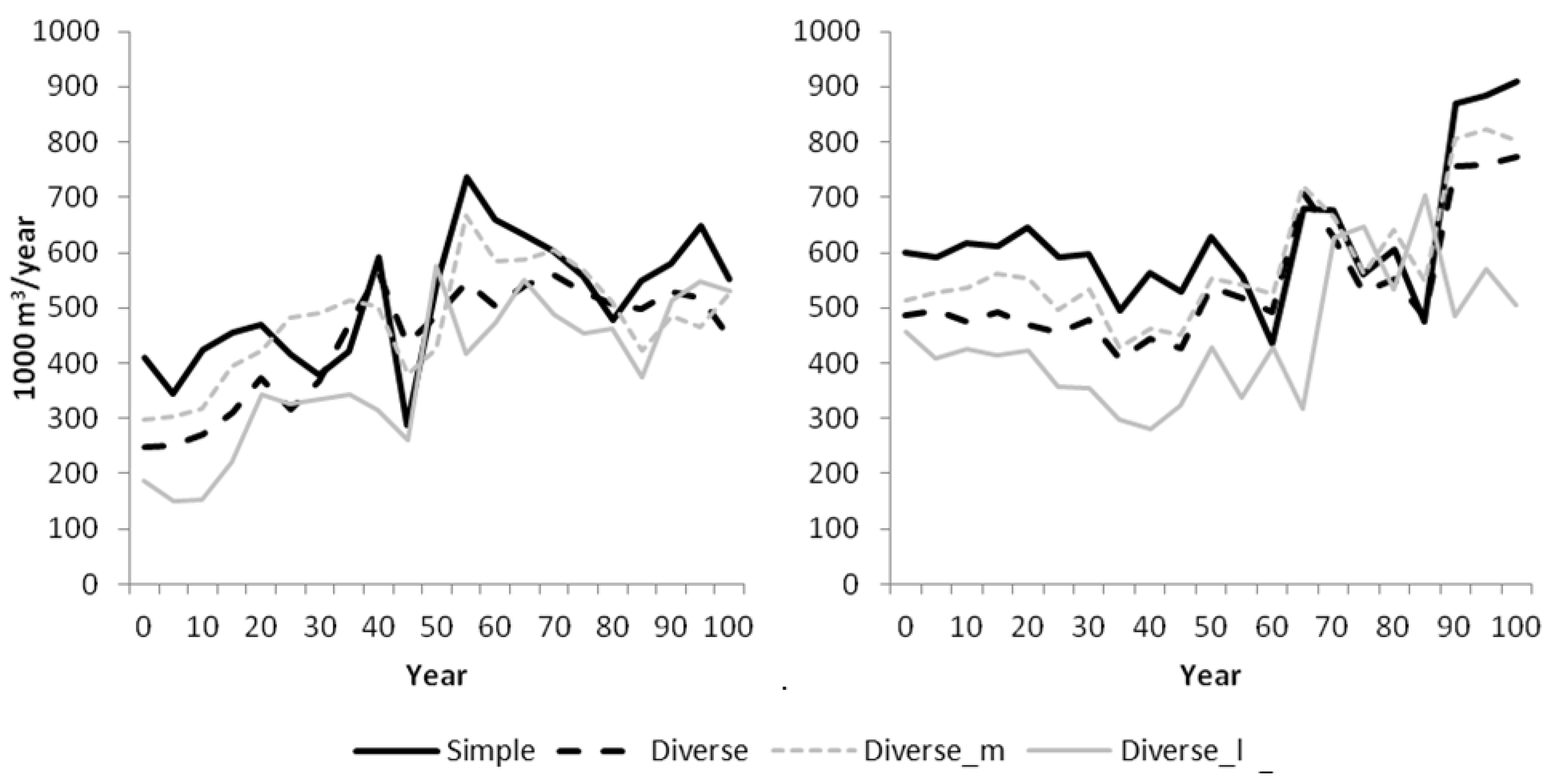
| Scenario | NPV (SEK per ha) | Mean Annual Harvest (1000 m3) | ||
|---|---|---|---|---|
| Hässleholm | Vilhelmina | Hässleholm | Vilhelmina | |
| Simple | 73954 | 14956 | 511 | 625 |
| Diverse | 64359 | 12254 | 441 | 541 |
| Diverse_m | 69161 | 13402 | 474 | 581 |
| Diverse_l | 55344 | 9710 | 382 | 443 |
3.1.2. Growing Stock

3.1.3. Growth

3.1.4. Potential Reindeer Winter Pasture
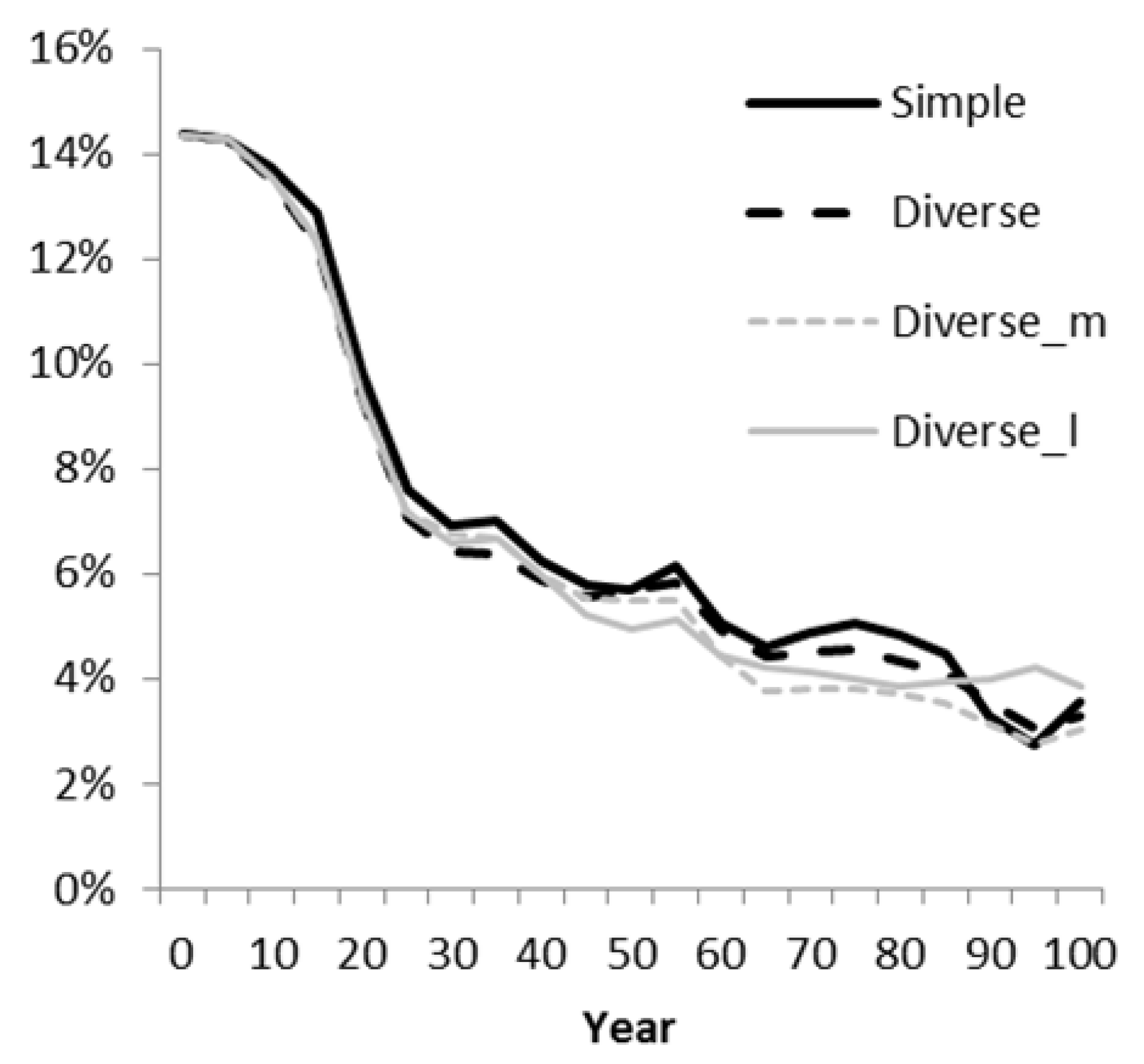
3.2. Ecological Indicators
3.2.1. Mature Forest with a High Share of Broadleaves
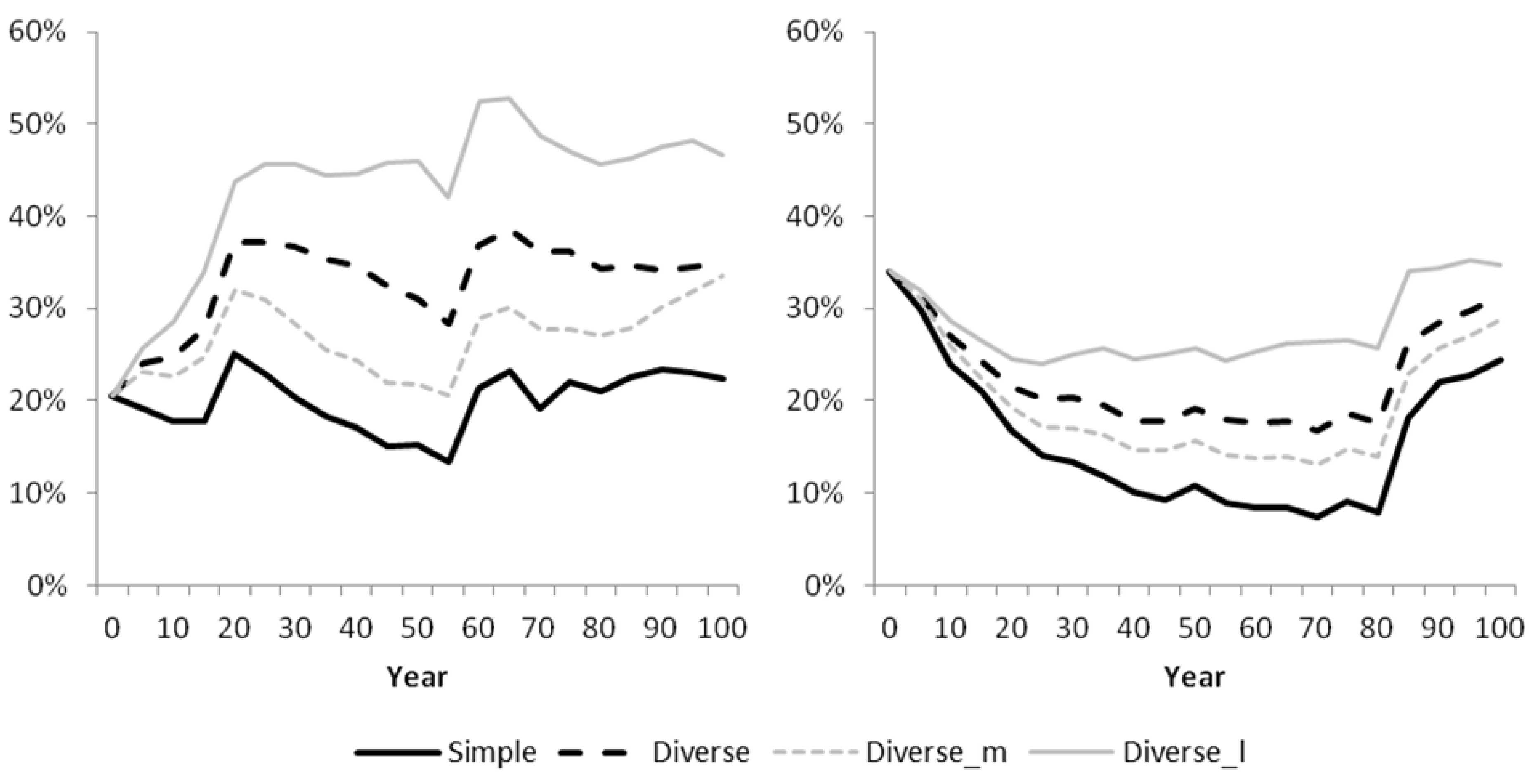
3.2.2. Old Forest
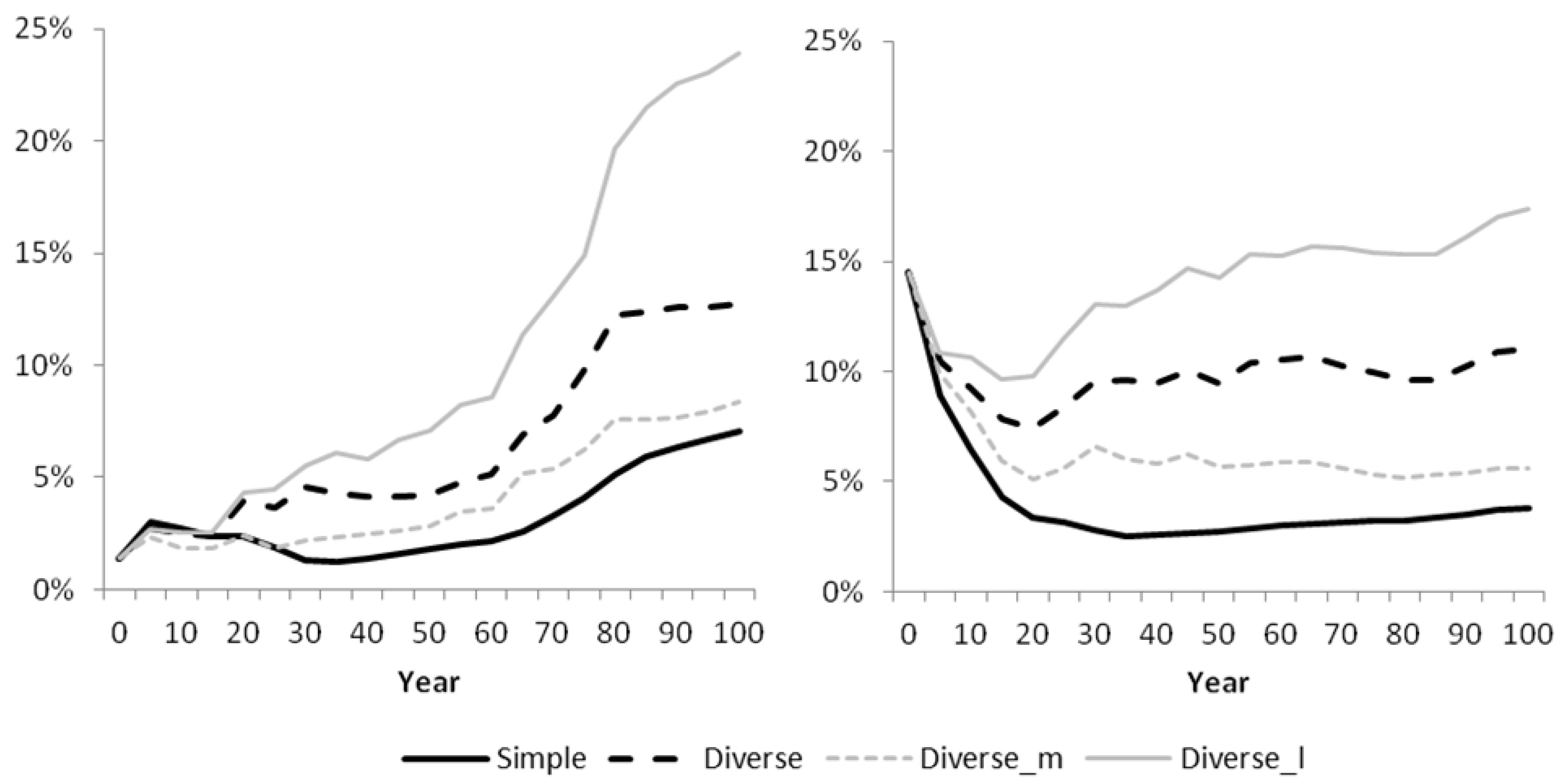
3.2.3. Large Diameter Trees

3.2.4. Fresh Deadwood
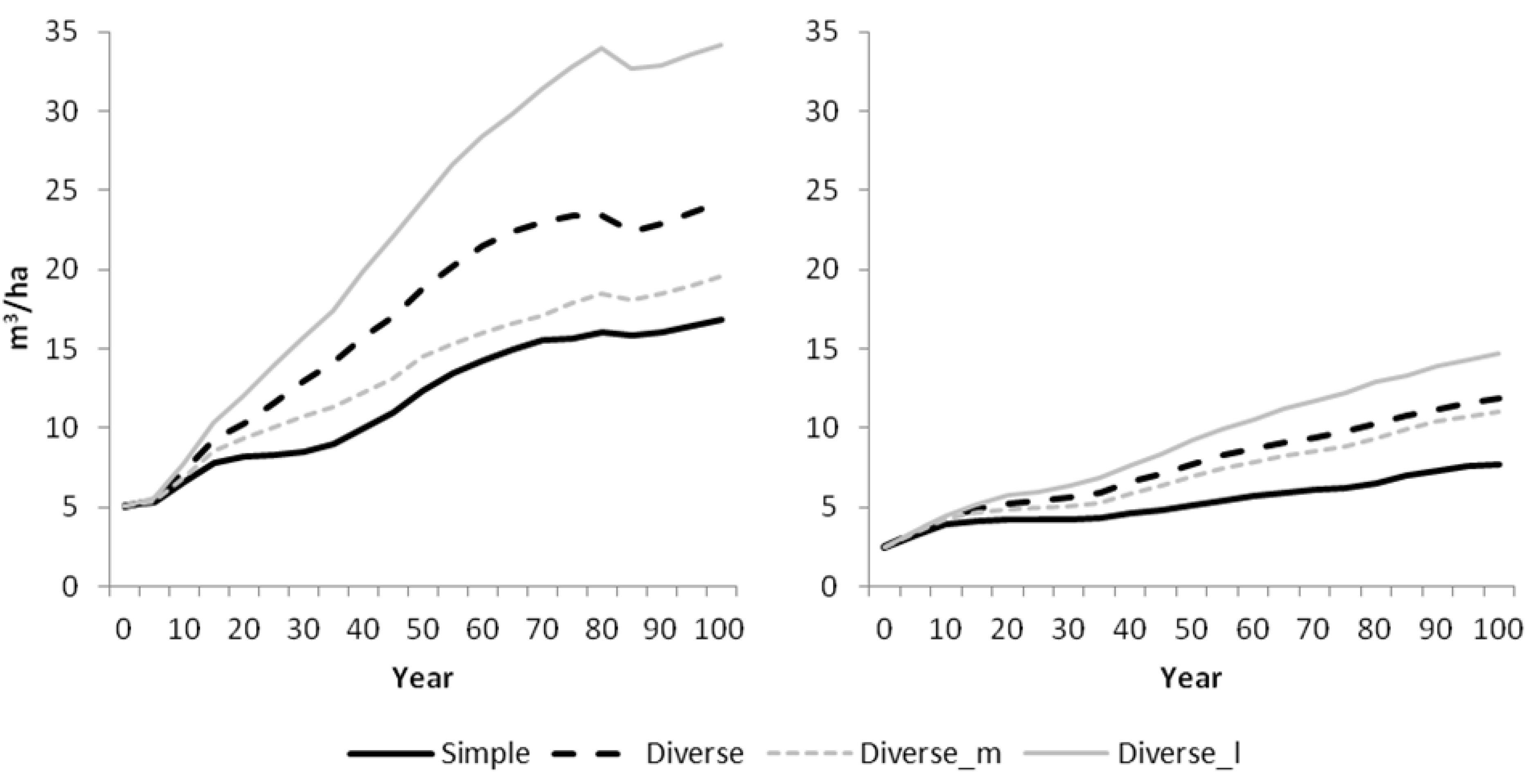
3.3. Social Indicators
3.3.1. Sparse Forests

3.3.2. Clear-Cut Area
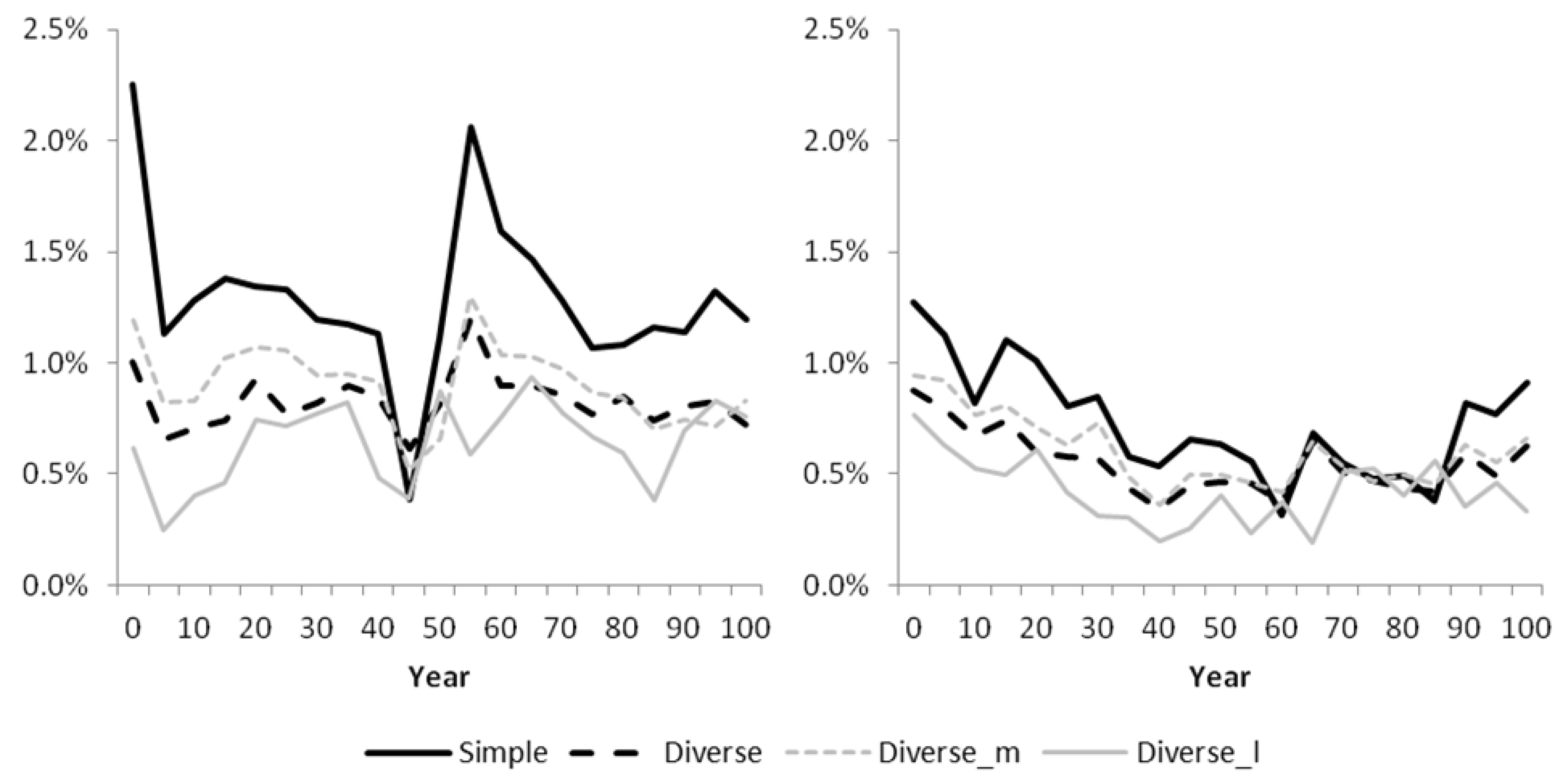
3.3.3. Person-Years

3.4. Integrative Assessment
| Indicator | After 20 Years | After 100 Years | |||||
|---|---|---|---|---|---|---|---|
| Simple | Diverse | Diverse_m | Diverse_l | Diverse | Diverse_m | Diverse_l | |
| Economic | |||||||
| Total harvest | 1 | 0.71 | 0.85 | 0.51 | 0.86 | 0.82 | 0.84 |
| Growing stock | 1 | 1.28 | 1.18 | 1.45 | 1.23 | 1.17 | 1.45 |
| Growth | 1 | 1.08 | 1.06 | 1.12 | 0.91 | 0.96 | 0.83 |
| Ecological | |||||||
| Mature forest with high share of broadleaves | 1 | 1.48 | 1.27 | 1.74 | 1.57 | 1.51 | 2.09 |
| Old forest | 1 | 1.67 | 1.02 | 1.85 | 1.81 | 1.19 | 3.40 |
| Large diameter trees | 1 | 1.97 | 1.15 | 2.37 | 1.73 | 1.17 | 3.13 |
| Fresh deadwood | 1 | 1.26 | 1.15 | 1.48 | 1.44 | 1.16 | 2.03 |
| Social | |||||||
| Sparse forest | 1 | 1.54 | 1.30 | 1.88 | 1.94 | 1.83 | 2.76 |
| Clear-cut area | 1 | 0.59 | 0.73 | 0.36 | 0.64 | 0.69 | 0.55 |
| Person-years | 1 | 0.71 | 0.89 | 0.56 | 0.80 | 0.94 | 0.77 |
| Indicator | After 20 Years | After 100 Years | |||||
|---|---|---|---|---|---|---|---|
| Simple | Diverse | Diverse_m | Diverse_l | Diverse | Diverse_m | Diverse_l | |
| Economic | |||||||
| Total harvest | 1 | 0.78 | 0.88 | 0.68 | 0.88 | 0.95 | 0.72 |
| Growing stock | 1 | 1.14 | 1.09 | 1.20 | 1.37 | 1.27 | 1.58 |
| Growth | 1 | 1.04 | 1.04 | 1.05 | 1.01 | 1.05 | 0.92 |
| Potential reindeer winter pasture | 1 | 0.94 | 0.95 | 0.96 | 0.92 | 0.85 | 1.08 |
| Ecological | |||||||
| Mature forest with high share of broadleaves (%) | 1 | 1.29 | 1.14 | 1.47 | 1.29 | 1.18 | 1.43 |
| Old forest | 1 | 2.22 | 1.53 | 2.94 | 2.89 | 1.47 | 4.55 |
| Large diameter trees | 1 | 0.32 | 0.38 | 6.28 | 1.01 | 1.44 | 2.75 |
| Fresh deadwood | 1 | 1.25 | 1.16 | 1.36 | 1.55 | 1.44 | 1.91 |
| Social | |||||||
| Sparse forest | 1 | 1.23 | 1.16 | 1.46 | 1.84 | 1.41 | 2.82 |
| Clear-cut area | 1 | 0.69 | 0.79 | 0.56 | 0.74 | 0.80 | 0.60 |
| Person-years | 1 | 0.78 | 0.87 | 0.69 | 0.86 | 0.92 | 0.70 |
3.5. Differences by Forest Owner Category
| Owner Type | Non-Industrial Private Owners | Other Owners | ||||||||||
|---|---|---|---|---|---|---|---|---|---|---|---|---|
| After 20 Years | After 100 Years | After 20 Years | After 100 Years | |||||||||
| Simple | Diverse | Rel. ∆ | Simple | Diverse | Rel. ∆ | Simple | Diverse | Rel. ∆ | Simple | Diverse | Rel. ∆ | |
| Economic indicators | ||||||||||||
| Total harvest (1000 m3/year) * | 371 | 259 | −0.30 | 519 | 433 | −0.16 | 53 | 42 | −0.19 | 63 | 65 | 0.03 |
| Growing stock (m3/ha) | 177 | 229 | 0.30 | 282 | 361 | 0.28 | 206 | 241 | 0.17 | 347 | 343 | −0.01 |
| Growth (m3/ha/year) * | 7.1 | 7.7 | 0.08 | 8.7 | 7.9 | −0.10 | 7.4 | 7.8 | 0.05 | 8.1 | 8.0 | −0.02 |
| Ecological indicators | ||||||||||||
| Mature forest with high share of broadleaves (%) | 20 | 37 | 0.81 | 21 | 35 | 0.65 | 29 | 39 | 0.34 | 28 | 33 | 0.17 |
| Old forest (%) | 2 | 4 | 0.74 | 6 | 13 | 1.15 | 3 | 5 | 0.39 | 14 | 12 | −0.13 |
| Large diameter trees (trees/ha) | 6.4 | 13.2 | 1.05 | 11.3 | 22.2 | 0.97 | 8.7 | 13.8 | 0.6 | 25.7 | 26.9 | 0.05 |
| Fresh deadwood (m3/ha) | 7.9 | 10.1 | 0.29 | 15.8 | 24.7 | 0.56 | 9.73 | 11.2 | 0.1 | 23.7 | 21.4 | −0.10 |
| Social indicators | ||||||||||||
| Sparse forest (%) | 17 | 27 | 0.57 | 10 | 21 | 1.05 | 22 | 31 | 0.40 | 14 | 20 | 0.44 |
| Clear-cut area (%) * | 1.3 | 0.8 | −0.42 | 1.2 | 0.8 | −0.37 | 1.2 | 0.8 | −0.34 | 1.0 | 0.7 | −0.24 |
| Person-years (years) * | 140 | 98 | −0.30 | 178 | 139 | −0.22 | 21 | 16 | −0.21 | 22 | 22 | 0.00 |
| Owner Type | Non-Industrial Private Owners | Other Owners | ||||||||||
|---|---|---|---|---|---|---|---|---|---|---|---|---|
| After 20 Years | After 100 Years | After 20 Years | After 100 Years | |||||||||
| Simple | Diverse | Rel. ∆ | Simple | Diverse | Rel. ∆ | Simple | Diverse | Rel. ∆ | Simple | Diverse | Rel. ∆ | |
| Economic indicators | ||||||||||||
| Total harvest (1000 m3/year) * | 276 | 210 | −0.24 | 345 | 277 | −0.20 | 340 | 273 | −0.20 | 440 | 417 | −0.05 |
| Growing stock (m3/ha) | 84 | 95 | 0.14 | 139 | 202 | 0.45 | 82 | 92 | 0.13 | 144 | 187 | 0.30 |
| Growth (m3/ha/year) * | 2.2 | 2.4 | 0.06 | 3.3 | 3.4 | 0.02 | 2.4 | 2.4 | 0.03 | 3.4 | 3.3 | −0.01 |
| Potential reindeer winter pasture (%) | 7 | 7 | 0.01 | 4 | 3 | −0.33 | 12 | 11 | −0.09 | 3 | 4 | 0.18 |
| Ecological indicators | ||||||||||||
| Mature forest with high share of broadleaves (%) | 19 | 24 | 0.23 | 23 | 32 | 0.42 | 14 | 15 | 0.06 | 26 | 31 | 0.19 |
| Old forest (%) | 4 | 8 | 0.88 | 4 | 10 | 1.35 | 2 | 7 | 1.71 | 3 | 12 | 2.49 |
| Large diameter trees (trees/ha) | 0.1 | 0.0 | −0.64 | 0.7 | 1.6 | 1.32 | 0.0 | 0.0 | −0.5 | 0.7 | 1.3 | 0.73 |
| Fresh deadwood (m3/ha) | 4.64 | 5.64 | 0.22 | 7.86 | 12.33 | 0.57 | 3.83 | 4.91 | 0.28 | 7.49 | 11.45 | 0.53 |
| Social indicators | ||||||||||||
| Sparse forest (%) | 14 | 16 | 0.20 | 10 | 20 | 0.89 | 12 | 15 | 0.24 | 9 | 16 | 0.79 |
| Clear-cut area (%) * | 1.0 | 0.7 | −0.31 | 0.7 | 0.4 | −0.38 | 1.1 | 0.7 | −0.31 | 0.7 | 0.6 | −0.15 |
| Person-years (years) * | 83 | 64 | −0.23 | 101 | 79 | −0.22 | 105 | 83 | −0.21 | 126 | 117 | −0.08 |
4. Discussion
5. Conclusions
Acknowledgments
Author Contributions
Conflicts of Interest
References
- Mantau, U.; Saal, U.; Prins, K.; Steierer, F.; Lindner, M.; Verkerk, H.; Eggers, J.; Leek, N.; Oldenburger, J.; Asikainen, A.; et al. EUwood—Real Potential for Changes in Growth and Use of EU Forest. Final Report; University of Hamburg (Centre of Wood Science) (UHAM): Hamburg, Germany, 2010; p. 160. [Google Scholar]
- Claesson, S. Skogsstyrelsen Skogliga Konsekvensanalyser 2008-SKA-VB 08; Skogsstyrelsen: Jönköping, Sweden, 2008; p. 157. [Google Scholar]
- UNECE/FAO. The European Forest Sector Outlook Study II. 2010–2030; United Nations: Geneva, Switzerland, 2011. [Google Scholar]
- Verkerk, P.J.; Anttila, P.; Eggers, J.; Lindner, M.; Asikainen, A. The realisable potential supply of woody biomass from forests in the European Union. For. Ecol. Manag. 2011, 261, 2007–2015. [Google Scholar] [CrossRef]
- Eggers, J.; Lindner, M.; Zudin, S.; Zaehle, S.; Liski, J. Impact of changing wood demand, climate and land use on European forest resources and carbon stocks during the 21st century. Glob. Chang. Biol. 2008, 14, 2288–2303. [Google Scholar] [CrossRef]
- Verkerk, P.J.; Mavsar, R.; Giergiczny, M.; Lindner, M.; Edwards, D.; Schelhaas, M.J. Assessing impacts of intensified biomass production and biodiversity protection on ecosystem services provided by European forests. Ecosyst. Serv. 2014, 9, 155–165. [Google Scholar] [CrossRef]
- Pussinen, A.; Nabuurs, G.J.; Wieggers, H.J.J.; Reinds, G.J.; Wamelink, G.W.W.; Kros, J.; Mol-Dijkstra, J.P.; de Vries, W. Modelling long-term impacts of environmental change on mid- and high-latitude European forests and options for adaptive forest management. For. Ecol. Manag. 2009, 258, 1806–1813. [Google Scholar] [CrossRef]
- Hengeveld, G.M.; Didion, M.; Clerkx, S.; Elkin, C.; Nabuurs, G.-J.; Schelhaas, M.-J. The landscape-level effect of individual-owner adaptation to climate change in Dutch forests. Reg. Environ. Chang. 2014. [Google Scholar] [CrossRef]
- Frank, S.; Fürst, C.; Pietzsch, F. Cross-Sectoral Resource Management: How Forest Management Alternatives Affect the Provision of Biomass and Other Ecosystem Services. Forests 2015, 6, 533–560. [Google Scholar] [CrossRef]
- Dunbar, M.B.; Panagos, P.; Montanarella, L. European perspective of ecosystem services and related policies. Integr. Environ. Assess. Manag. 2013, 9, 231–236. [Google Scholar] [CrossRef] [PubMed]
- Egoh, B.; Dunbar, M.B.; Maes, J.; Willemen, L.; Drakou, E.G.; European Commission; Joint Research Centre; Institute for Environment and Sustainability. Indicators for Mapping Ecosystem Services: A Review; Publications Office: Luxembourg, Luxembourg, 2012. [Google Scholar]
- Antón-Fernández, C.; Astrup, R. Empirical harvest models and their use in regional business-as-usual scenarios of timber supply and carbon stock development. Scand. J. For. Res. 2012, 27, 379–392. [Google Scholar] [CrossRef]
- Eid, T. Testing a large-scale forestry scenario model by means of successive inventories on a forest property. 2004, 38, 305–317. [Google Scholar]
- Boon, T.E.; Meilby, H.; Thorsen, B.J. An Empirically Based Typology of Private Forest Owners in Denmark: Improving Communication between Authorities and Owners. Scand. J. For. Res. 2004, 19, 45–55. [Google Scholar] [CrossRef]
- Ingemarson, F.; Lindhagen, A.; Eriksson, L. A typology of small-scale private forest owners in Sweden. Scand. J. For. Res. 2006, 21, 249–259. [Google Scholar] [CrossRef]
- Schaich, H.; Plieninger, T. Land ownership drives stand structure and carbon storage of deciduous temperate forests. For. Ecol. Manag. 2013, 305, 146–157. [Google Scholar] [CrossRef]
- Rinaldi, F.; Jonsson, R.; Sallnäs, O.; Trubins, R. Behavioral Modelling in a Decision Support System. Forests 2015, 6, 311–327. [Google Scholar] [CrossRef]
- Arano, K.G.; Munn, I.A. Evaluating forest management intensity: A comparison among major forest landowner types. For. Policy Econ. 2006, 9, 237–248. [Google Scholar] [CrossRef]
- Johnson, K.N.; Bettinger, P.; Kline, J.D.; Spies, T.A.; Lennette, M.; Lettman, G.; Garber-Yonts, B.; Larsen, T. Simulation forest structure, timber production, and socioeconomic effects in a multi-owner province. Ecol. Appl. 2007, 17, 34–47. [Google Scholar] [CrossRef]
- Zheng, D.L.; Heath, L.S.; Ducey, M.J.; Butler, B. Relationships Between Major Ownerships, Forest Aboveground Biomass Distributions, and Landscape Dynamics in the New England Region of USA. Environ. Manag. 2010, 45, 377–386. [Google Scholar] [CrossRef] [PubMed]
- Swedish Forest Agency. Swedish Statistical Yearbook of Forestry 2013; Skogsstyrelsen: Jönköping, Sweden, 2013. [Google Scholar]
- Simonsson, P.; Gustafsson, L.; Östlund, L. Retention forestry in Sweden: Driving forces, debate and implementation 1968–2003. Scand. J. For. Res. 2015, 30, 154–173. [Google Scholar] [CrossRef]
- Naturvårdsverket. Miljömålen. Årlig Uppföljning av Sveriges Miljökvalitetsmål och Etappmål 2014; Naturvårdsverket: Stockholm, Sverige, 2014; p. 306. [Google Scholar]
- Zaremba, M. Skogen vi Ärvde; Weyler: Stockholm, Sverige, 2012. [Google Scholar]
- Eggers, J.; Lämås, T.; Lind, T.; Öhman, K. Factors Influencing the Choice of Management Strategy among Small-Scale Private Forest Owners in Sweden. Forests 2014, 5, 1695–1716. [Google Scholar] [CrossRef]
- Gustafsson, K.; Hägg, S. Skogliga Konsekvensanalyser 2003 SKA 03; Skogsstyrelsen: Jönköping, Sweden, 2004; p. 52. [Google Scholar]
- SCB Area by Municipality 1 January 2015 (km2). Available online: http://www.scb.se/sv_/Hitta-statistik/Statistik-efter-amne/Miljo/Markanvandning/Land--och-vattenarealer/12838/12845/ (accessed on 24 September 2015).
- SCB Befolkningsstatistik. Available online: http://www.scb.se/be0101/ (accessed on 24 September 2015).
- EEA Biogeographical Regions. Available online: http://www.eea.europa.eu/data-and-maps/data/biogeographical-regions-europe-2 (accessed on 24 September 2015).
- SMHI Vegetationsperiodens längd. Available online: http://www.smhi.se/klimatdata/meteorologi/temperatur/vegetationsperiodens-langd-1.4076 (accessed on 23 September 2015).
- Reese, H.; Nilsson, M.; Pahén, T.G.; Hagner, O.; Joyce, S.; Tingelöf, U.; Egberth, M.; Olsson, H. Countrywide estimates of forest variables using satellite data and field data from the National Forest Inventory. Ambio 2003, 32, 542–548. [Google Scholar] [CrossRef] [PubMed]
- Fridman, J.; Ståhl, G. A Three-step Approach for Modelling Tree Mortality in Swedish Forests. Scand. J. For. Res. 2001, 16, 455–466. [Google Scholar] [CrossRef]
- Metria Markägarkartan (Ownership map). Available online: http://www.metria.se/Vara-erbjudanden/Kartor-och-bilder/Metria-som-geodataleverantor/Fastighetskartor/Markagarkartan/ (accessed on 2 September 2014).
- Skogsstyrelsen. Öppna data—Skogsstyrelsen. Available online: http://www.skogsstyrelsen.se/Myndigheten/Om-oss/Oppna-data/ (accessed on 27 May 2015).
- Skogsstyrelsen. Skogsdataportalen. Available online: http://skogsdataportalen.skogsstyrelsen.se/Skogsdataportalen/ (accessed on 25 September 2015).
- Naturvårdsverket. Naturvårdsverkets nedladdningstjänst för geodata. Available online: http://data.naturvardsverket.se/DataSet/Details/5 (accessed on 25 September 2015).
- Nilsson, H. Strategic Forest Planning Using AHP and TOPSIS in Participatory Environments. A Case Study Conducted in Wilhelmina, Sweden. Master’s Thesis, Swedish University of Agricultural Sciences (SLU), Umeå, Sweden, 2014. [Google Scholar]
- Statens Fastighetsverk Google Earth—Statens fastighetsverk. Available online: http://www.sfv.se/sv/fastigheter/skogar-och-marker/google-earth/ (accessed on 27 May 2015).
- Wikström, P.; Edenius, L.; Elfving, B.; Eriksson, L.O.; Lämås, T.; Sonesson, J.; Öhman, K.; Wallerman, J.; Waller, C.; Klintebäck, F. The Heureka Forestry Decision Support System: An Overview. Math. Comput. For. Nat.-Resour. Sci. 2011, 3, 87–95. [Google Scholar]
- Fahlvik, N.; Elfving, B.; Wikström, P. Evaluation of growth functions used in the Swedish Forest Planning System Heureka. Silva Fenn. 2014, 48. [Google Scholar] [CrossRef]
- Wikberg, P.-E. Occurrence, morphology and growth of understory saplings in Swedish forests. Available online: http://pub.epsilon.slu.se/610/ (accessed on 26 May 2015).
- Holm, S.; Lundström, A. Åtgärdsprioriteter (Management Priorities); SLU: Umeå, Sweden, 2000; p. 17. [Google Scholar]
- Södra. Virkesprislista—Södra. Available online: http://skog.sodra.com/sv/Salja-Virke/Virkesprislista/ (accessed on 26 March 2015).
- Norra Skogsägarna Prislistor—Norra Skogsägarna. Available online: http://www.norra.se/verksamhet/skogochvirke/Saljavirke/Sidor/prislistor.aspx (accessed on 11 February 2015).
- Brunberg, T. Underlag för Produktionsnorm för Engreppsskördare i Gallring (Basic Data for Productivity Norms for Single-Grip Harvesters in Thinning); Redogörelse nr 8; SkogForsk: Uppsala, Sweden, 1997. [Google Scholar]
- Brunberg, T. Underlag för Produktionsnorm för Stora Engreppsskördare i Slutavverkning (Basic data for productivity Norms for Heavy-Duty Single-Grip Harvesters in final Felling); Redogörelse nr 7; SkogForsk: Uppsala, Sweden, 1995. [Google Scholar]
- Brunberg, T. Underlag till produktionsnormer för skotare (Productivity-Norm Data for Forwarders); Redogörelse nr 3; Skogforsk: Uppsala, Sweden, 2004. [Google Scholar]
- Lämås, T.; Sandström, E.; Jonzén, J.; Olsson, H.; Gustafsson, L. Tree retention practices in boreal forests—What kind of future landscapes are we creating? Scand. J. For. Res. 2015, 30, 526–537. [Google Scholar] [CrossRef]
- Bettinger, P.; Boston, K.; Siry, J.P.; Grebner, D.L. Forest Management and Planning; Academic Press: Waltham, MA, USA, 2009. [Google Scholar]
- Biber, P.; Borges, J.G.; Moshammer, R.; Barreiro, S.; Botequim, B.; Brodrechtová, Y.; Brukas, V.; Chirici, G.; Cordero-Debets, R.; Corrigan, E.; et al. How Sensitive Are Ecosystem Services in European Forest Landscapes to Silvicultural Treatment? Forests 2015, 6, 1666–1695. [Google Scholar] [CrossRef]
- Forest Europe; UNECE; FAO. State of Europe’s Forests 2011. Status and Trends in Sustainable Forest Management in Europe; United Nations: Geneva, Switzerland, 2011. [Google Scholar]
- Petersson, H.; Holm, S.; Ståhl, G.; Alger, D.; Fridman, J.; Lehtonen, A.; Lundström, A.; Mäkipää, R. Individual tree biomass equations or biomass expansion factors for assessment of carbon stock changes in living biomass—A comparative study. For. Ecol. Manag. 2012, 270, 78–84. [Google Scholar] [CrossRef]
- Triviño, M.; Juutinen, A.; Mazziotta, A.; Miettinen, K.; Podkopaev, D.; Reunanen, P.; Mönkkönen, M. Managing a boreal forest landscape for providing timber, storing and sequestering carbon. Ecosyst. Serv. 2015, 14, 179–189. [Google Scholar] [CrossRef]
- Korosuo, A.; Sandström, P.; Öhman, K.; Eriksson, L.O. Impacts of different forest management scenarios on forestry and reindeer husbandry. Scand. J. For. Res. 2014, 29, 234–251. [Google Scholar] [CrossRef]
- Nilsson, S.G.; Hedin, J.; Niklasson, M. Biodiversity and its assessment in boreal and nemoral forests. Scand. J. For. Res. 2001, 16, 10–26. [Google Scholar] [CrossRef]
- Roberge, J.-M.; Lämås, T.; Lundmark, T.; Ranius, T.; Felton, A.; Nordin, A. Relative contributions of set-asides and tree retention to the long-term availability of key forest biodiversity structures at the landscape scale. J. Environ. Manag. 2015, 154, 284–292. [Google Scholar] [CrossRef] [PubMed]
- Gustafsson, L. Presence and Abundance of Red-Listed Plant Species in Swedish Forests. Conserv. Biol. 2002, 16, 377–388. [Google Scholar] [CrossRef]
- Liira, J.; Kohv, K. Stand characteristics and biodiversity indicators along the productivity gradient in boreal forests: Defining a critical set of indicators for the monitoring of habitat nature quality. Plant Biosyst. Int. J. Deal. Asp. Plant Biol. 2010, 144, 211–220. [Google Scholar] [CrossRef]
- Lundström, J.; Öhman, K.; Perhans, K.; Rönnqvist, M.; Gustafsson, L.; Bugman, H. Cost-effective age structure and geographical distribution of boreal forest reserves. J. Appl. Ecol. 2011, 48, 133–142. [Google Scholar] [CrossRef] [PubMed]
- Lassauce, A.; Paillet, Y.; Jactel, H.; Bouget, C. Deadwood as a surrogate for forest biodiversity: Meta-analysis of correlations between deadwood volume and species richness of saproxylic organisms. Ecol. Indic. 2011, 11, 1027–1039. [Google Scholar] [CrossRef]
- Djupström, L. Conservation of Saproxylic species an Evaluation of Set-Asides and Substrates in Boreal Forests; Dept. of Ecology, Swedish University of Agricultural Sciences: Uppsala, Sweden, 2010. [Google Scholar]
- Nordström, E.-M.; Holmström, H.; Öhman, K. Evaluating continuous cover forestry based on the forest owner’s objectives by combining scenario analysis and multiple criteria decision analysis. Silva Fenn. 2013, 47. [Google Scholar] [CrossRef]
- Gundersen, V.S.; Frivold, L.H. Public preferences for forest structures: A review of quantitative surveys from Finland, Norway and Sweden. Urban For. Urban Green 2008, 7, 241–258. [Google Scholar] [CrossRef]
- Fredman, P.; Stenseke, M.; Sandell, K.; Mossing, A. Friluftsliv i Förändring; Naturvårdsverket: Stockholm, Sverige, 2013. [Google Scholar]
- Fredman, P.; Margaryan, L. The Supply of Nature-based Tourism in Sweden : A National Inventory of Service Providers; European Tourism Research Institute: Mittuniversitetet, Sweden, 2014. [Google Scholar]
- NFI. Fältinstruktion 2014, Riksinventeringen av Skog; SLU: Umeå, Sweden, 2014; p. 470. [Google Scholar]
- Eriksson, L. Åtgärdsbeslut i Privatskogsbruket (Treatment Decisions in Privately Owned Forestry); SLU: Uppsala, Sweden, 2008. [Google Scholar]
- Eyvindson, K.; Kangas, A. Using a Compromise Programming Framework to Integrating Spatially Specific Preference Information for Forest Management Problems. J. Multi-Criteria Decis. Anal. 2015, 22, 3–15. [Google Scholar] [CrossRef]
- Lidskog, R.; Sjödin, D. Why do forest owners fail to heed warnings? Conflicting risk evaluations made by the Swedish forest agency and forest owners. Scand. J. For. Res. 2014, 29, 275–282. [Google Scholar] [CrossRef]
- Seidl, R.; Schelhaas, M.-J.; Lexer, M.J. Unraveling the drivers of intensifying forest disturbance regimes in Europe. Glob. Chang. Biol. 2011, 17, 2842–2852. [Google Scholar] [CrossRef]
- Blennow, K. Adaptation of forest management to climate change among private individual forest owners in Sweden. For. Policy Econ. 2012, 24, 41–47. [Google Scholar] [CrossRef]
- Drössler, L.; Fahlvik, N.; Elfving, B. Application and limitations of growth models for silvicultural purposes in heterogeneously structured forest in Sweden. J. For. Sci. 2013, 59, 458–473. [Google Scholar]
- Elfving, B.; Wikberg, P.-E. Jämförelse av Observerad och Med Heureka Beräknad Utveckling på Urskogsytorna (Comparison of Observed and Heureka-Simulated Development of Primeval Forest Areas), Unpublished work. 2015.
- Reese, H.; Nilsson, M.; Sandström, P.; Olsson, H. Applications using estimates of forest parameters derived from satellite and forest inventory data. Comput. Electron. Agric. 2002, 37, 37–55. [Google Scholar] [CrossRef]
- Lindner, M.; Maroschek, M.; Netherer, S.; Kremer, A.; Barbati, A.; Garcia-Gonzalo, J.; Seidl, R.; Delzon, S.; Corona, P.; Kolström, M.; et al. Climate change impacts, adaptive capacity, and vulnerability of European forest ecosystems. For. Ecol. Manag. 2010, 259, 698–709. [Google Scholar] [CrossRef]
- Keenan, R.J. Climate change impacts and adaptation in forest management: A review. Ann. For. Sci. 2015, 72, 145–167. [Google Scholar] [CrossRef]
- Wilby, R.L.; Dessai, S. Robust adaptation to climate change. Weather 2010, 65, 180–185. [Google Scholar] [CrossRef]
© 2015 by the authors; licensee MDPI, Basel, Switzerland. This article is an open access article distributed under the terms and conditions of the Creative Commons Attribution license (http://creativecommons.org/licenses/by/4.0/).
Share and Cite
Eggers, J.; Holmström, H.; Lämås, T.; Lind, T.; Öhman, K. Accounting for a Diverse Forest Ownership Structure in Projections of Forest Sustainability Indicators. Forests 2015, 6, 4001-4033. https://doi.org/10.3390/f6114001
Eggers J, Holmström H, Lämås T, Lind T, Öhman K. Accounting for a Diverse Forest Ownership Structure in Projections of Forest Sustainability Indicators. Forests. 2015; 6(11):4001-4033. https://doi.org/10.3390/f6114001
Chicago/Turabian StyleEggers, Jeannette, Hampus Holmström, Tomas Lämås, Torgny Lind, and Karin Öhman. 2015. "Accounting for a Diverse Forest Ownership Structure in Projections of Forest Sustainability Indicators" Forests 6, no. 11: 4001-4033. https://doi.org/10.3390/f6114001






